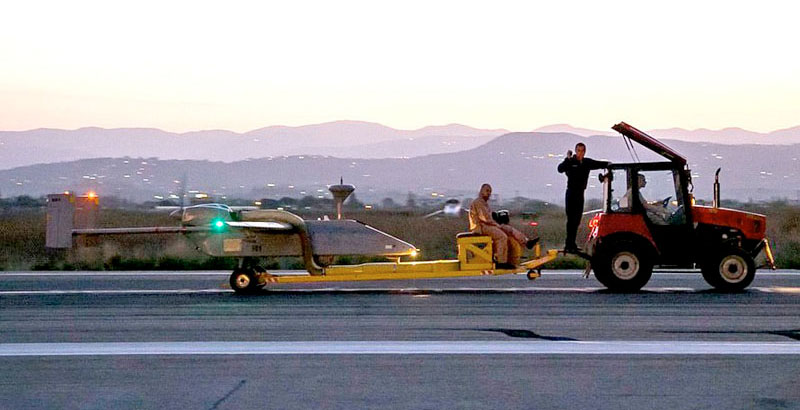Russian UAVs are successfully used in Syria for various purposes.

The Russian Forpost unmanned aerial vehicle at an air base in Syria (Photo: geo-politica.info)
A special correspondent of the Otvaga military-patriotic website visited an airport in Aleppo and talked with a commander of a detachment of unmanned aerial vehicles, operating on the territory of Syria.
The correspondent noted that while Russian unmanned fighting vehicles are still in the implementation phase, such drones as the Orlan and the Forpost have already proved to be excellent in Syria.
According to the commander, Russian unmanned aerial vehicles (UAVs) perform search-and-rescue tasks in Syria. He reminded the incident with the Russian Su-24M, which was shot down last fall, and noted that an UAV found the downed aircraft. The Major also said that drones are used to accompany humanitarian convoys and monitor a ceasefire.
The commander added that Russian UAVs are also used for combat purposes – they conduct air reconnaissance, direct the air power to targets, correct the fire of Syrian artillery, and monitor the results of airstrikes of fighter jets and strikes of ground fire units.
He also noted that Syrian militants repeatedly tried to shoot down Russian drones.
“Some [of the UAVs] landed, having more than one hole in its fuselage, wings and other places. But [the drones] reached their airfield and landed,” the Major said.
As the Major said, Russian UAVs operate at day and night, as the Forpost is equipped with a multi-purpose opto-electronic camera. They are capable to stay in the air during 12 hours and overcome a distance of more than 150 kilometers at a height up to 4,500 meters. Usually, Russian UAVs make up to four sorties per day, but sometimes the number of flights can be even more.

The Russian Forpost unmanned aerial vehicle in the Syrian sky (Photo: Syrian Military Capabilities)

A detachment prepares an unmanned aerial vehicles for a new sortie (Photo: otvaga2004.ru / Alexander Kolotilo)

A detachment prepares an unmanned aerial vehicles for a new sortie (Photo: otvaga2004.ru / Alexander Kolotilo)






12 hours, 150km? what’s the limiting factor here?
Press releases of actual capabilities.
1500km is more reasonable
Data link range.
It’s said that 150km is for omnidirectional antenna mode, for directive antenna range would rise to 250km.
Oh, and it’s just israelian IAI Searcher II manufactured in Russia by licence =D
Probably our industry was testing own capabilities to produce such stuff earlier in 2012, no big deal.
Using replaceable modules could also work due to weight limitations. Same machine/frame could carry:
1- monitoring cameras for surveillance or target accuracy
2- Laser guidance for artillery
3- light weight machines guns
4- small scale missile or drop bombs (considering the payload limitation they can still carry a noticeable current options)